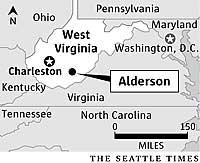Martha Stewart checks into prison today

Alderson was the nation's first federal women's prison and has housed such storied names as Billie Holiday, "Tokyo Rose," Axis Sally and would-be presidential assassins Lynette "Squeaky" Fromme and Sara Jane Moore. The campuslike collection of cottages in the West Virginia mountains opened in 1927 as part of a reform movement as a place where "fallen" women could reclaim dignity and learn skills.
Prison-reform advocates note that it remains one of the best prisons for women, offering vocational training and GED classes. But they contend it is overcrowded, understaffed and short on funds for some programs.
In addition, it now follows a punitive rather than a rehabilitative model, and critics contend there's intimidation, humiliation and sexual harassment. In short, at least to today's reformers, it's a symbol of all that's wrong with how the criminal-justice system deals with women.
And just as the creation of Alderson was sparked by suffragettes appalled by inhumane conditions, some advocates are hoping that Stewart's stay for lying about a stock sale will turn her into an avid prison activist.
There is a long precedent for such activism, from Jean Harris, who did time for killing the author of the Scarsdale Diet, to Susan McDougal, who was incarcerated for refusing to testify before independent counsel Kenneth Starr.
"They both turned that situation into one where they could shed light on the problems encountered in women's prisons, and certainly Martha has an opportunity to do that as well," said Susan Galbraith, founder of Our Place, a nonprofit prison-advocacy center in Washington, D.C. "It's one of the most characteristic ways that women do time. They ask: 'How can I turn this horrendous experience into something positive for women who are going to follow me?' "
In 1970, women made up 3 percent of the prison population nationwide. More than half the states didn't even have separate facilities, according to Meda Chesney-Lind, a criminologist at the University of Hawaii.
Little changed until the 1980s, when a combination of factors created a women's prison surge. Some experts note the deterioration of the family and to women's increased economic instability. But most contend the biggest factor was get-tough mandatory-minimum drug laws. They were intended to net drug kingpins but instead snared millions of low-level offenders, including many women. The result: The number of women in prison skyrocketed from about 12,000 in 1980 to more than 100,000 in 2003.
State and federal officials started building prisons quickly. Critics say, however, that instead of developing the kind of rehabilitative model upon which Alderson was founded, men's prisons were replicated.
"Women's institutions are literally men's institutions, only we pull out the urinals," said Chesney-Lind. "The irony between that historic era and the current mode of women's incarceration couldn't be starker."
Alderson never has had walls or razor wire. It was built as a series of cottages. Each had a library, kitchen and dining room, and each inmate had a small room. Guards were female, and they lived in the cottages with the inmates, who sewed, cooked and were educated under their supervisor's care.
"It was women reaching out and helping other women to reclaim their self-respect and dignity," said Clare Hanrahan, a writer and anti-war activist who served six months at Alderson two years ago on a trespassing charge.
Today, the historic cottages are used mostly for housing. Several have been torn down and replaced by a large dormitory for as many as 500 inmates. Another is under construction.
Hanrahan says there is no privacy, and male guards routinely walk in on women in the bathroom and pull bedcovers off at night to verify head counts. "They say, 'We must see flesh, ladies!' " Hanrahan said. "It's humiliating."
The correctional-officers union has complained that they are severely understaffed, with one officer per 550 women during the day and two at night. Staffing levels are one-third lower than they were four years ago, they contend. But the U.S. Bureau of Prisons insists its staffing is adequate.
Together, budget constraints and overcrowding have drained resources for educational and other programs. A teacher shortage has meant some GED classes are taught by inmates.
But other women of means who have served at Alderson and other prisons say it will be the other inmates whose plight will affect Stewart the most. Most are minority with a low income and have a history of sexual abuse. They also are struggling with drug addictions and sometimes the loss of children to the state.
"It's just a tremendously needy population that is not getting the services they really need," said Cheryl Stein, a publicist and freelancer who served four months for bankruptcy fraud at the federal prison camp in Danbury, Conn. "If Martha can be touched by their plight, their lack of control, and their victimization, she will become a prison reformer."
Details about past inmates at Alderson were provided by The Associated Press.